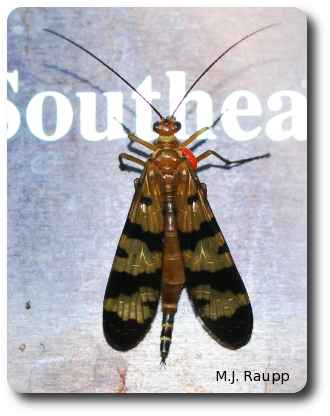Chilly temperatures and wintry weather create conditions unfavorable for hunting and photographing bugs in the wilds of Maryland. We returned to our mailbox to answer questions sent by bug aficionados earlier in the year. This week’s discovery came from an eagle-eyed homeowner who found a chimeral insect on a sprig of poison ivy in her yard. This creature had the elongated face of an aardvark, mottled membranous wings of a fly, and a strange appendage on its tail that resembled the sting of a scorpion. Little wonder this insect has earned the name scorpionfly.
A female scorpionfly basks on a sunny sign along the forest's edge.
Scorpionflies are infrequently seen, denizens of forests and where the forest’s shady edge meets the meadow. Adult scorpionflies eat nectar, fruit, and the juicy remains of dead and dying insects. Larval scorpion flies live on or just beneath the surface of the soil where they hunt other small insects or scavenge organic matter. The large stinger-like appendage on the rear end of the scorpion fly is not a stinger at all. Rather, it is genetalia used for mating and found only on the male. Female scorpionflies lack this remarkable structure. Courtship in scorpionflies has an element of romance about it. Males of many species try to win a mate by presenting a nuptial gift to the intended mother of their larvae. This gift may be a small caterpillar or fly. If she accepts the gift, the deal is consummated. If the gift is inadequate, then the unlucky suitor and his present are rejected. Winter is a fine time to observe a close relative of the scorpionfly called the snow scorpionfly. Learn about its frosty antics by clicking on the following link - Dashing through the snow, Snow scorpionflies, Boreus sp.
References:
Bug of the Week thanks June Tveekrem for providing the great image of a male scorpionfly and the inspiration for this episode. The delightful book “The Insects: An Outline of Entomology” by P. J. Gullan and P. S. Cranston was used as a reference for this episode. To learn more about scorpionflies, please visit the following web site.
http://entomology.ifas.ufl.edu/foltz/eny3005/lab1/Other_Orders/Panorpid.htm

